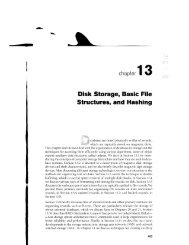this pdf excerpt
this pdf excerpt
this pdf excerpt
Create successful ePaper yourself
Turn your PDF publications into a flip-book with our unique Google optimized e-Paper software.
T-<br />
Chapter 3 Data Modeling Using the Entity-Relationship (ER) Model<br />
Figure 3.6<br />
Two entity types, EMPLOYEE<br />
and COMPANY, and some<br />
member entities of each.<br />
Entity Type Name: EMPLOYEE<br />
Entity Set:<br />
(Extension)<br />
Name, Age, Salary<br />
COMPANY<br />
Name, Headquarters, President<br />
c1 o<br />
(Sunco Oil, Houston, John Smith)<br />
C2o<br />
(Fast Computer, Dallas, Bob King)<br />
Arr entity type describes the schema or intension for a set of entities tirat share thc<br />
same structure. The collection of entities of a particular entity type is grouped into<br />
an entity set, which is also called the extension of the entity t)'pe.<br />
Key Attributes of an Entity Type. An important constrainr on rhe entities of an<br />
entity type is the key or uniqueness constraint on attributes. An entity type usuallr<br />
hars an attribute whose values are distinct for each individual entity in the entity set.<br />
Such an attribute is calied a key attribute, and its values can be useci to identifr<br />
each entity uniquely. For exarnple, the Name attribute is a key of the coMpANy<br />
entity type in Figure 3.6 because no two companies are allowed to have the same<br />
name. For the PERSoN entity type, a typical key attribute is ssn (Social Securitr<br />
Number). Sornetirnes several attributes together form a key, meaning that the corrrbination<br />
of the attribute values must be distinct for each entity. If a set of attributes<br />
possesses <strong>this</strong> propertv, the proper way to represent <strong>this</strong> in the ER model that wr'<br />
describe here is to define a contposite attribute and designate it as a key attribute oi<br />
the entity type. Notice that such a composite key rnust be ntirtintal; that is, all component<br />
attributes must be included in the composite attribute to have the uniqueness<br />
property. Superfluous attributes must not be included in a key. In ER<br />
diagrammatic r.rotatior-r, each key attribute has its name underlined inside the oval.<br />
as illustrated in Figure 3.7(a).<br />
Specifying thirt an attribr.rte is a key of an entitv type means that the preceding<br />
uniqueness property rnust hold for every cntitl,5gs of the entitv type. Hence, it is.r<br />
constrair-rt that prohibits any two entities from having the same value for the ker<br />
attribute at the same time. It is not the property of a particular extensiorr; rather, ir<br />
is a constraint on a// e-rtensiotls of the entitv type. This key constraint (and other<br />
constraints we di-scr.rss later) is derived from the constraints of the miniworld that<br />
the database re[)resen ts.














